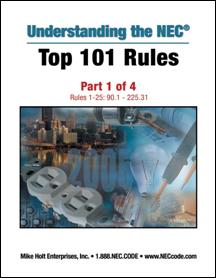Top 101 NEC Rules – Part 1 of 4
 This PDF is a free resource from Mike Holt Enterprises, Inc. It is always our pleasure to give back to the industry as much as we can, whenever we can. For this reason we’ve created this free “Top 101 Rules” from Mike's Understanding the NEC, Volume 1, 2005 Edition textbook. These are the top 101 rules that Mike and his team feel are the most important for every electrician to know.
This PDF is a free resource from Mike Holt Enterprises, Inc. It is always our pleasure to give back to the industry as much as we can, whenever we can. For this reason we’ve created this free “Top 101 Rules” from Mike's Understanding the NEC, Volume 1, 2005 Edition textbook. These are the top 101 rules that Mike and his team feel are the most important for every electrician to know.
It’s a quick reference and guide to make sure you’re up to speed on these very important rules.
We’ve divided this file into 4 parts for easy downloading. We’ll be sending one part out each month over the next 4 months. This month is Part 1 (Rule 1-25). An outline of the 25 rules is listed below.
Click on the following link below to start your download.
Download: Top 101 Rules – Part 1 (8.59 MB)
If you encounter any problems, be sure you have the latest version of Adobe Acrobat installed. You may click here to install the latest version now. Be advised that this download may take a few minutes.
Rule 1—90.1 Purpose of the NEC
Rule 2—90.2 Scope of the NEC
Rule 3—90.3 Code Arrangement
Rule 4—90.4 Enforcement
Rule 5—90.5 Mandatory Requirements and Explanatory Material.
Rule 6—90.7 Examination of Equipment for Product Safety
Rule 7—110.2 Approval of Equipment
Rule 8—110.3 Examination, Identification, Installation, and Use of Equipment
Rule 9—110.14 Conductor Termination
Rule 10—110.16 Flash Protection Warning
Rule 11—110.26 Spaces About Electrical Equipment
Rule 12—200.6 Identification of the Grounded Neutral Conductor
Rule 13—200.7 Use of White or Gray Color
Rule 14—210.3 Branch-Circuit Rating
Rule 15—210.4 Multiwire Branch Circuits
Rule 16—210.5 Identification for Branch Circuits
Rule 17—210.8 GFCI-Protected Receptacles
Rule 18—210.12 Arc-Fault Circuit-Interrupter (AFCI) Protection
Rule 19—210.19 Conductor Sizing
Rule 20—210.20 Overcurrent Protection
Rule 21—210.21 Outlet Device Rating
Rule 22—210.52 Dwelling Unit Receptacle Outlet Requirements
Rule 23—225.18 Clearances
Rule 24—225.30. Number of Supplies
Rule 25—225.31 Disconnecting Means